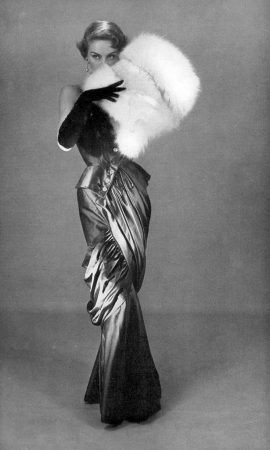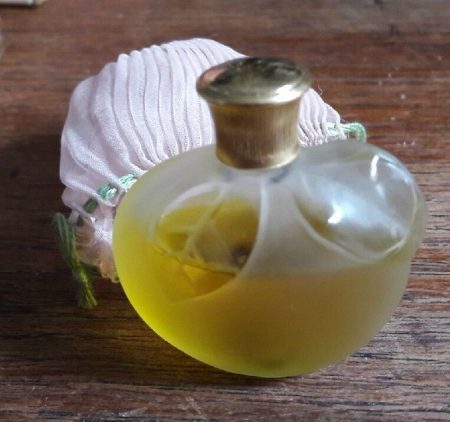
Nina Ricci Fille d’Eve gown George Saad
Nina Ricci’s earlier perfumes constitute some of the most classical fragrances one may encounter – prime examples of a certain school of courteously seductive élan. Often they resemble her exquisite gowns: elegant, sparkling, eternally youthful and always in good taste. And then, of course – there is always one which breaks the mold. 1952’s Nina Rici Fille D’Eve (Daughter of Eve) is such a one with its joyful, sunny preamble: the kiss of spice that encircles bright, sweet blossoms and juicy fruits. Beware: beneath lacy underpinnings and crinoline lurks an unanticipated growl which is not to be found in any of her other fragrances.
There are those who might find Mme. Ricci’s aromatic output to be fusty, old-maid-ish, grandmotherly perhaps in the current climate. Often folk equate classicism with being outdated – but they are not necessarily interchangeable. Like any fine design, the ageless quality of a beautifully constructed fragrance will stand the test of time. It is unfortunate that Fille D’Eve has been discontinued, because it smells absolutely right for the era we inhabit right now. And this is precisely why I’d like to share some of my own stash with one of you, dear readers.

1952 Nina Ricci Fille D’Eve ad via Nina Ricci
First and foremost, none of the women who surrounded me in the 1950s wore Fille D’Eve, that’s for certain. They smelt enchanting, to be sure – but they were ‘too ladylike’ to be lured. Women most often wore their aldehydic florals, green floral chypres, and usually only when they went out, along with their string of pearls and talons hauts. A little fur shrug, perhaps (usually mink with the little paws and beady eyes which glared at you!). We small children would be enveloped in a cloak of Arpège de Lanvin, Sortilège de Le Galion, Millot’s Crêpe de Chine or Réplique de Raphael before they left for those rare evenings of adult pleasure – a concert, ballet, symphony, even the cinema (and if they were really lucky, the opera!).

Costus root via ebay
What sows the seeds of iniquity in a scent which might otherwise melt into a sea of delightful fruity/spicy florals? Besides those glorious (and IFRA-deplored) nitromusks of yore? It’s costus – that rooty vegetal musk whose calling card is the celebration of a somewhat unwashed scalp. Savvy perfumers have employed it to spectacular effect: think Dawn Spencer Hurwitz retro-animalic favorites (of mine and yours) Foxy, L’Étole de Vison, Musc Eau Natural, Rendezvous; MDCI’s Chypre Palatin by Bertrand Duchaufour; By Killian A Taste of Heaven; Francesca Bianchi’s Under My Skin; April Aromatics Purple Reign; Papillon Dryad; and Senyokô La Tsarine, to name but a few. It’s one of those animalics that are unforgettable; one smelt, it cannot be un-smelt. The highly-skilled sneak it in there from time to time in minuscule doses to extend longevity and/or create an insidious sub-atmosphere. You might liken it to the furry underbelly of a gentle beast…

French Riviera Hotel Garden with Bathers unknown 1950s
Nina Ricci Fille D’Eve opens with a flourish of lush lemon and bergamot – pure sunshine. Following on citrus heels, the plenitude of a summer garden and adjacent orchard welcome your eager senses: sultry jasmine, entangled honeysuckle vines in full bloom; roses waft as peaches and plums ripen on the nearby branch. Clove is present, but not the dominant note; a sweet warm spice by nature, it’s a seasoning and not a solo performer. The base would be sufficiently delicious with its inky oakmoss, feathery incense notes and lashings of amber – but that’s not all. What’s under that magnificent bespoke dress, but musks which leave you breathless…and something else. Costus. At first, unsettling and nakedly animalic for a plant; quite the unexpected touch from perfumers Michael Hy (creator of Emilio Pucci Vivara and Paco Rabanne Calandre) and Jacques Bercia (YSL Rive Gauche, Y and Monsieur de Rauch). Once the nose becomes accustomed, costus warms the entire composition with a dusky aureole of sensuality, a perfumed languor of the limbs, heavy-lidded eyes of the enraptured. Fille D’Eve progresses over time from the garden to the seraglio.
Notes: bergamot, lemon, jasmine, honeysuckle, rose, clove, peach, plum, oakmoss, balsamic incense notes, costus, amber, animalic musk
~ Ida Meister, Senior and Natural Perfumery Editor

rare Lalique flacon of Fille D’Eve via louise-bonheur on eBay
Ida firmly believes that everyone should have the opportunity to experience perfume unicorns whenever possible! In that spirit, she will gladly decant 4 mls. (in a small glass cube) of Nina Ricci Fille D’Eve pure perfume for one registered reader worldwide. It is in pristine 1950s condition. You must register or your comment will not count. To be eligible, please leave a comment saying what appeals to you about Ida’s review, and where you live. Draw closes 1/9/220
Follow us on Instagram @cafleurebon @idameister
This is our Privacy and Draw Rules Policy
There is no spilled perfume
